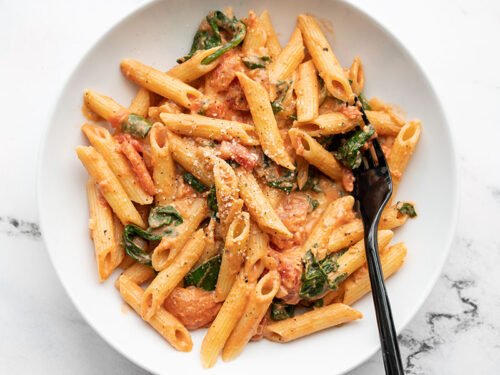How to make pasta
I find it very therapeutic to make pasta. I think because, at the end of it, you have delicious food and it’s very satisfying – it’s a bit like bread making. I’ve made pasta since I was eight or nine when I used to make it with my grandmother.
There are two basic ingredients: flour and eggs, or flour and water. You can use plain flour – you don’t need to use fancy 00 flour – and if you haven’t got eggs, you can make it with water. You’re not being controversial, there’s egg pasta and non-egg pasta. There are lots of variations. Some people just use yolks and, in the south of Italy, people only use water. Use what you feel you can achieve in these unusual circumstances and times.
One of the best tips I have is that when you’re kneading it and it doesn’t stick to your hands, that means it’s the right consistency. If it sticks to your hands, or it hasn’t come together, you’re not there yet.

Makes 600g
00 pasta flour 400g
salt ½ tsp
eggs 4
olive oil 1 tbsp
Mix the flour and salt together and tip on to a work surface or board. Make a well in the centre.
Mix together the eggs and oil and pour two-thirds into the well, reserving the rest. Starting from the outside, work the flour into the liquid until a dough forms. The dough is conditioned by its environment, so depending on the warmth of your kitchen and hands, you may need to add the remaining egg mixture if the dough doesn’t come together. Knead until it is smooth, firm and elastic (this will take 5–10 minutes). Wrap in clingfilm and rest in the fridge for 1 hour before using. The dough will keep for up to 24 hours in the fridge if wrapped tightly first in clingfilm and then in foil.
Cut the dough into 3–4 pieces and use a rolling pin or the palm of your hand to flatten a piece to the width of the pasta machine. Make sure the pasta machine is on its widest setting and run each piece of dough through it twice. Reduce the setting by one notch and run it through twice again. If the dough feels a bit sticky, add a little flour, but not too much, as this will dry it out.
Run it through the machine twice on each notch until you get to the narrowest or second narrowest notch, depending on the type of pasta (see below). Halfway through this process fold the dough in half before finishing rolling.
.jpeg
Roll the dough as described above and then run it twice through the last but one notch. The sheet of pasta should be about 30cm in length. To cut into tagliatelle, use the attachment that comes with the machine. Sprinkle the dough with a little flour before running it through, catching the ribbons over your arm as they come out of the other side. Divide the ribbons in half and form into little nests – each nest is about enough for one person as a starter portion. Set aside to dry out for 20 minutes before use. (You can leave the tagliatelle to dry for up to 1 hour, but the pasta becomes more brittle the longer it is left.)
If you don’t have the tagliatelle attachment, simply roll up the pasta into a pinwheel and, using a sharp knife, slice into strips 8–10 mm thick. Separate the ribbons and form nests, as above.

Key points for cooking pasta
The water must be seasoned well with plenty of salt at the point when it comes to the boil – allow about 1 tablespoon of salt for a large pan of water.
All the pasta must be covered with water.
Stir the pasta when it first goes into the water and then leave alone.
Always cook it to the point where it becomes al dente.
Drain it well.
A pet hate of mine is when people cook the pasta in boiling water, but then drain and rinse it under cold water, washing off the starch. The starch is what allows the pasta and sauce to amalgamate. But the worst sin of all is to serve the pasta straight into a bowl and spoon the sauce on without mixing it in.

This is a great, simple dish, perfect in the summer when fresh peas are in season. For vegetarians, use goat’s cheese or ricotta instead of parma ham.
Serves 4
pasta dough 1 quantity (see recipe above)
fresh peas 200g, podded weight
olive oil 50ml, plus extra for drizzling
garlic 1 clove, crushed
mint a handful, freshly chopped
parmesan a handful, freshly grated
parma ham 8 slices, or 200g of soft goat’s cheese, crumbled
Roll out the pasta and cut into tagliatelle as described above. Set aside.
Bring a medium pan of salted water to the boil. Add the peas and cook for 2–3 minutes. Drain and plunge into iced water. Set aside.
Heat the olive oil in a pan over a low heat and add the garlic. Cook for 1 minute, then add the drained peas and cook for a further 2–3 minutes. Remove from the heat and set aside.
Bring a large pan of salted water to the boil and cook the tagliatelle for 3–4 minutes, until al dente.
Drain and add to the pea mixture. Toss well, then season to taste and add the chopped mint and a drizzle of olive oil. Sprinkle in the parmesan and drape over the parma ham, or scatter with the goat’s cheese, before serving
.jpeg)